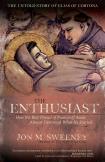Friend of Francis
Few saints have so firmly captured the collective Christian imagination and had such enduring impact as Francis of Assisi. The current pope not only adopted the mystic and reformer’s name; he has also drawn theological and pastoral orientation from Francis’ love of creation and of evangelical poverty. The saint’s charism still animates numerous religious orders that bear his name. He is honored (if that is the word) in countless garden statues, to say nothing of the annual blessing of domestic pets on his feast day, Oct. 4.
With all respect to these most blessed animals, it is St. Francis who has been domesticated. The Enthusiast, Jon M. Sweeney’s latest book, provides ample support for this conclusion. The medieval penitent who renounced wealth to embrace radical Gospel simplicity has morphed into a jovial, finch-toting hippie. Sweeney’s book narrates the intersection of Francis’ life with that of Elias of Cortona (also called Elias of Assisi), the man arguably responsible for both Francis’ enduring renown and his domestication.
For the historically minded, the fascination that surrounds Francis can easily yield to frustration. He captivates even as the story of his life is a complicated mixture of fact, myth and hagiography. What is true of Francis is doubly, perhaps triply, true of Elias. His identity and story have been obscured by gaps and silences in the historical record—and by the (typically unflattering) portraits painted of him by others.
Few have heard of Elias, but all Francis devotees owe him a debt. It was Elias who first reported the saint’s stigmata, the wounds of Christ he bore in his flesh. Moreover, as Sweeney notes, Elias was instrumental in helping Francis reach the status of Christianity’s most beloved saint. The Basilica di San Francesco in Assisi was first constructed under his leadership, intended to draw pilgrims and swell his cult. Elias was determined that a “greater than Gothic” church should memorialize the humble Poverello.
Elias’s legacy is unquestionably controversial. He twice served as leader of the Franciscan movement as Francis’ “vicar general” (1221-27) and later as the order’s second “minister general” (1232-39) following the founder’s death. Particularly during this second period, his leadership veered toward the tyrannical. The grandeur of the way he commemorated Francis and rumors of a lavish life among popes and prelates led to charges that he compromised the order’s strict observance of poverty, the cornerstone of the Franciscan charism. Deposed as minister general by his (former) friend Gregory IX, Elias allied against the pope with Frederick II, the Holy Roman Emperor. Though reconciled with the church before his death, Elias remained estranged from—and often vilified by—the order he helped build.
These details are relatively well attested in Franciscan sources and scholarship. The subtitle of Sweeney’s new book, “The Untold Story of Elias of Cortona,” is thus alluring. Is there more to know about this important figure?
Alas, the story has remained untold because we know so little about the details of his life. This makes Elias a difficult subject for a biography, and Sweeney acknowledges as much. Although he is the enthusiast of the book’s title, at various points in the text Elias recedes from view almost entirely. In the end, this is more properly a biography of Francis that tries to involve Elias as often as possible.
What new material Sweeney relates about Elias depends mostly on the author’s own imagination. He is forthright that the book is “imagining a portrait of one of Francis’s closest friends….” Sweeney has “invented dialogue” between characters “to tell this true story.” Doing this requires ventriloquizing a mute historical record. Still, Sweeney skillfully weaves together his own historical research with an imaginative rendering of Francis and Elias. The problem for readers, especially for those not intimately acquainted with Franciscan sources, is in marking the boundary between history and speculation (however plausible).
At the risk of interpreting a Franciscan work through an Ignatian lens, Sweeney is engaged in something like imaginative contemplation of the overlapping lives of Francis and Elias. This method enables Sweeney to “tell this story as one who witnessed it and has just come running back from it” and results in a suggestive and thought-provoking book.
This new volume accomplishes a rare feat. It is cautious even as it is bold and daring. Sweeney is a student of the appropriate historical sources and of the scholarship surrounding them and has an obvious gift for making these accessible to nonspecialists. And, for all his knowledge of the standard narratives about Francis and Elias, Sweeney resists being confined by them.
Nowhere is this clearer than in his explanation of why Francis named Elias vicar in 1221. Others explain this as a function of Francis’ self-awareness. Realizing that the growing movement needed a competent administrator, he tapped Elias, who possessed these talents. Sweeney, however, roots this decision in Francis’ loyalty to their longstanding friendship, supposedly stretching back to childhood. The only problem is that we have no evidence whatsoever to suggest that the men knew each other before adulthood. Again, Sweeney concedes this fact. But this raises the larger issue of whether the book is an “untold story” or a fantasy based on true events.
The reader’s overall impression of The Enthusiast will hinge, most likely, on his or her initial expectations. Those who are seeking a straightforward account of what we confidently know about Francis and Elias are likely to be somewhat disappointed. Those who, like Sweeney, wish to engage gaps in the known past imaginatively will find in these pages a stimulating glimpse of two complex and important figures from the Christian tradition.
This article also appeared in print, under the headline “Friend of Francis,” in the August 29-September 6, 2016, issue.








